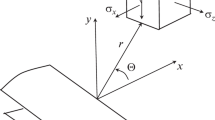Abstract
Fracture from a straight crack under mixed mode loading conditions and small scale of yielding is studied. It is assumed that crack growth occurs in either mode I or mode II. Comparison of theoretically obtained values of the mode I stress intensity factor at incipient kinking with experimental results indicates that mode I is preferred to mode II when the loading is such that the crack surfaces are traction-free, i.e. in the absence of a confining pressure. Mode II would be preferred only if the ratio K II c/K I c between the stress intensity factors is very low, between 0.38–0.81, depending on the load situation. Since there are reasons to believe that most materials are characterized by higher values of K II c/K I c, the conclusion is that mode II hardly occurs in the absence of a high confining pressure.
Résumé
On etudie la rupture entraînée par une fissure droite sujette à des sollicitations selon un mode mixte et comportant une plastification sur une petite échelle. On suppose que la croissance de la fissure se produit sous un mode I ou un mode II.
En comparant les valeurs théoriques du facteur d'intensité de contraintes selon le mode I correspondant à l'évasement initial et les résultats expérimentaux, il s'indique que le mode I est privilégié par rapport au mode II lorsque la sollicitation est telle que les surfaces de la fissure sont libres de toutes contraintes, c'est-à-dire en l'absence de toute pression de confinement.
Le mode II ne serait privilégié que si le rapport K II c/K I c des facteurs d'intensité de contraintes est très faible, à savoir entre 0,38 et 0,81, selon les conditions de sollicitation.
Comme il y a de bonnes raisons de croire que la plupart des matériaux sont caractérisés par des rapports K II c/K I c plus élevés, on en conclut que, en l'absence de hautes pressions de confinement, le mode II a peu de chances de se manifester.
Similar content being viewed by others
References
F. Erdogan and G.C. Sih, Journal of Basic Engineering (1963) 519–525.
H.A.Richard, Bruchvorhersagen bei Überlagerter Normal- und Schubbeanspruchung sowie reiner Shubbelastung von Rissen, Habilitionsschrift Universität, Kaiserslauten (1984).
H. Kordisch, Untersuchungen zum Verhalten von Rissen unter überlagerter Normal- und Scherbeanspruchung, Disseration Universität, Karlsruhe (1982). Results from [3–5] were taken from [2].
H.Kordisch, U.Seidelmann, U.Soltesz and E.Sommer, Undersuchung zum Bruchverhalten bei 060 überlagerter Normal-und Scherbeanspruchung, 8, Sitzung des Arbeitskreises Bruchvorgänge, Köln (1976). Results from [3–5] were taken from [2].
H. Kordisch and E. Sommer, Bruchkriterien bei überlagerter Normal- und Scherbeanspruchung von Rissen, Abschlußbericht des DFG, Forschungsvorhabens So 104/2, IWM, Bericht W/6-77, Freiburg (1978). Results from [3–5] were taken from [2].
SolveigMelin, The Infinitesimal Kink, Report LUTFD2/(TFHF-3022)/1–19, Department of Solid Mechanics, Lund Institute of Technology, Lund, Sweden (1985).
A.A.Khrapkov, International Journal of Fracture 7 (1971) 373–382.
G.C.Sih, International Journal of Fracture 10 (1974) 305–321.
H.C.Strifors, International Journal of Solids and Structures 10 (1974) 1389–1404.
H.Bergkvist and L.Guex, International Journal of Fracture 15 (1975) 429–441.
L.G.Pärletun, Engineering Fracture Mechanics 11 (1979) 343–358.
B.Cotterell and J.R.Rice, International Journal of Fracture 16 (1980) 155–169.
SolveigMelin, Which is the Most Unfavourable Crack Orientation? Report LUTFD2/(TFHF-3018)/1–16, Department of Solid Mechanics, Lund Institute of Technology, Lund, Sweden (1985).
B.A.Bilby and G.E.Cardew, International Journal of Fracture 11 (1975) 708–712.
SolveigMelin, International Journal of Fracture 30 (1986) 103–114.
Author information
Authors and Affiliations
Rights and permissions
About this article
Cite this article
Melin, S. Fracture from a straight crack subjected to mixed mode loading. Int J Fract 32, 257–263 (1986). https://doi.org/10.1007/BF00018544
Received:
Accepted:
Issue Date:
DOI: https://doi.org/10.1007/BF00018544




